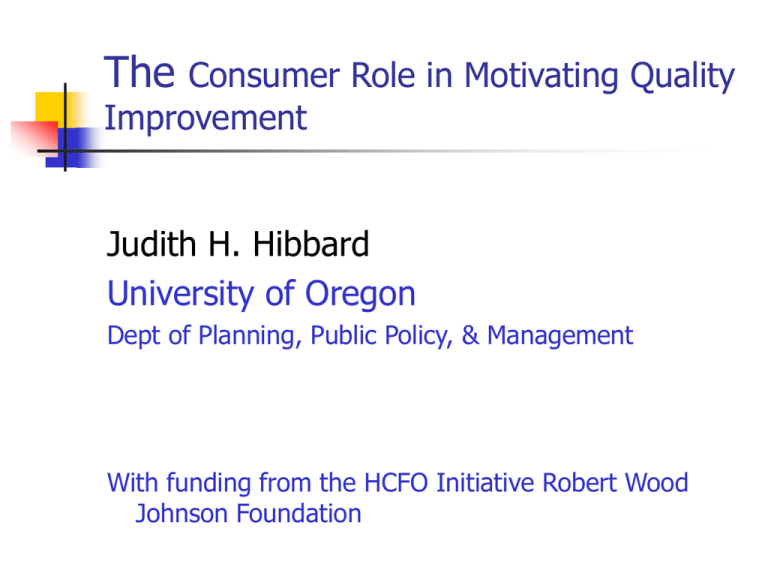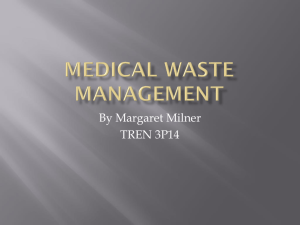The Consumer Role in Motivating Quality Improvement Judith H. Hibbard
advertisement

The Consumer Role in Motivating Quality Improvement Judith H. Hibbard University of Oregon Dept of Planning, Public Policy, & Management With funding from the HCFO Initiative Robert Wood Johnson Foundation Assumptions About How Public Reports Can Affect Quality Improvement 1 2 3 consumers can drive improvements through informed choice [market share] concerns about public image can motivate improvements [reputation] the feedback about own performance might be sufficient to motivate improvements [feedback] What is the Consumer Role? Pathway 1: [market share] Pathway 2: [reputation] Use comparative Performance information to make a hospital choice Observe that there are differences Be able to identify high and low performing hospitals Remember them Talk to others about the high and low performers Pathway 3: [feedback] No role for consumers Evaluation of the QualityCounts Hospital Report The Alliance produced and disseminated a report on 24 hospitals in S. Central WI Report rated hospitals on complications and deaths administrative data-- risk adjusted Public report widely disseminated Employees of The Alliance member companies Inserted in Newspaper Newspaper stories Community groups/ library/Website What the symbols mean: Fewer mistakes, complications and deaths than expected Average number of mistakes, complications and deaths More mistakes, complications and deaths than expected Regional Hospitals Surgery Non-Surgery Hip/Knee Cardiac Maternity Hospital A Hospital B Hospital C Hospital D Community Hospitals * Surgery Non-Surgery Hip/Knee Cardiac Maternity Hospital F Hospital G Hospital H Hospital I Hospital J Hospital K Hospital L Hospital M * Hospital N Hospital O Hospital P * Hospital Q * Impact of report on Hospitals: Experimental Design 115 Eligible Hospitals in Wisconsin 24 Alliance service area (Hospitals In Public Report) 91 Non-Alliance Hospitals Random Assignment 46 No Report Hospitals 45 Private Report Hospitals* * Three hospitals were lost to closure and two hospitals were ineligible due to overlapping administrative structures Research Questions: Does Making Performance Public Increase: QI efforts within areas reported upon? Are QI efforts greatest among those with lower performance scores? To what degree do ‘private reports’ stimulate QI activities? Actual improvements in care? Average number of quality improvement activities to reduce obstetrical complications: Public report group has more QUALITY IMPROVEMENT (p < .01, n = 93) 7.0 6.0 5.0 4.0 4.0 2.7 3.0 2.1 2.0 1.0 0.0 Public-Report Best practices around c-sections Best practices around v-bacs Reducing 3rd or 4th degree laceration Private-Report No-Report Reducing hemorrhage Reducing pre-natal complications Reducing post-surgical complications Other Hospitals with poor OB scores: # of QI activities by experimental condition (p = .001, n = 34) 6 5.5 5 4 3 2.5 2 2.1 1 0 Public-Report Private-Report No-Report Percent of hospitals with significant Improvements or Declines in OB Performance in the Post-Report Period: 40% 35% 35% 30% 23% 25% 20% 14% 15% 10% 13% 13% 5% 5% 0% Public Report Private Report No Report Significant Improvement Significant Decline Percentage of hospitals who had poor scores at baseline and who improved their scores in the post-report period 100% 90% 80% 88% 70% 60% 50% 40% 42% 33% 30% 20% 10% 0% Public Report (n=8) Private Report (n=15) No Report (n=12) Belief: Likelihood that the report would affect their hospital’s public image (N = 79) 5.0 Enhance 5 Scores: 3.6 Neither Enhance 3 nor detract 3.5 3.3 3.4 3.1 3.2 3.2 2.6 Detract 1 Public-Report Private-Report No-Report Main effects, p < .05, interaction effects, p < .05 Worse As expected Better The stimulus for QI appeared to be concern that the public report would affect their hospital reputation The findings indicate that it is all about reputation. Did the QualityCounts report affect hospital reputations? In the short term? In the long term? Did consumers come away with: An overall impression that there are better and worse options? Are impressions about which hospitals are better remembered? Did they discuss the report with others? Evaluation of the impact of the report on consumers Surveyed Prior to distribution of report: Alliance Member Employees Community members (RDD sample) Surveyed after the distribution of report: Employee panel (N= 93) RDD panel (N= 67) RDD post only (N= 469) Surveyed 2 years later: New RDD sample (N= 729) Percentage of Respondents Who Saw the Report, Saw News Stories about the Report, or Heard about the Report from Others. 60% 56.5% Percent of Respondents 50% Employees Panel RDD Panel RDD Post-only 40% 30% 25.4% 20% 14.8% 16.3% 15.2% 12.2% 10% 14.0% 10.4% 8.8% 0% Saw Report Saw News Stories Heard about report from others Exposure to the Performance Report Post (RDD only) (n=465) 2 years later (n=729) Remember Exposed to Seeing Report in Report some way* 15% 24% 6% * Saw, read about, or heard about the performance report 14% How the Hospital Report was Used: Immediately after release and 2 years later 50% 46% 40% 30% 24% 20% 10% 10% 4% 2% 2% 0% Used report to recommend Talked to others about the Talked to doctor about the or choose a hospital report report Immediately Post 2 Years Later Correctly Identified Highly Rated Hospitals 40% 35% 30% 25% 20% 15% 10% 5% 0% Pre Immediately Post*** Was not exposed to report *** p < .001 2 Years Later*** Was exposed to report Correctly Identified Low Rated Hospitals 70% 60% 50% 40% 30% 20% 10% 0% Pre Immediately Post*** Was not exposed to report * p < .05, *** p < .001< 2 Years Later* Was exposed to report Reports can influence consumers Evidence for an impact on consumer perceptions of hospital quality– with diminishing but observable long-term effects People talked about the report and influenced the views of others Implication: Public Reporting Does Work It does stimulate quality improvement -- primarily through a concern for reputation Consumers do have a role, but it does not necessarily involve choice. Feedback, and market share were not found to be significant pathways in this study






